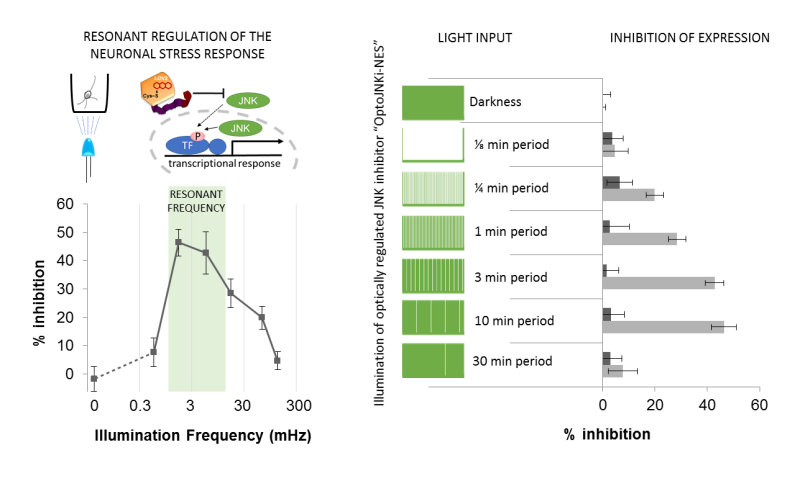Researchers use flashes of light to control signalling circuits in living cells

Researchers at the Turku Centre for Biotechnology have invented new tools for decoding and controlling signalling circuits in living cells with flashes of light. In principle, any cellular circuit can now be targeted with the new method. By using this approach, the researchers discovered that major biological signaling circuits can be made to resonate when driven at their resonant frequency.
Resonance is a familiar concept in music, physics and engineering, and underlies technical approaches in chemistry, biology and medicine.
"Our discovery that signalling circuits of mammalian cells can made to resonate is new, and likely to have a relevance in the treatment of diseases. With this method, we can control when the signaling pathway is on or off," says senior researcher Michael Courtney from Turku Centre for Biotechnology at the University of Turku and Åbo Akademi University, Finland.
The team developed optogenetic inhibitors for protein kinases such as JNK, which is a central regulator of cell function.
"The JNK protein in the cell cytoplasm was not thought to regulate gene expression in the nucleus, and we considered continuous inhibition in the cytoplasm to be ineffective. However, the team found that delivering a specific frequency of inhibition pulses to JNK in the cytoplasm drove inhibition of gene expression in the nucleus. This indicates that cell signaling circuits can be controlled in previously unknown ways once the appropriate time code has been identified," says Courtney.
He explains that not only might cell circuit resonance play an unexpected role in degenerative disease processes, but it could even guide the discovery of new therapeutic approaches. Interestingly, the only previous report on cell circuit resonance in the scientific literature showed it can be used to prevent microbial cells from growing. This new discovery of similar behaviour in mammalian cells suggests it could potentially be used to stop cancer cells from growing.
"Currently, the development of resistance to new drugs is a major problem in cancer, as it cost billions of dollars to develop and approve new drugs, and yet they can rapidly become ineffective as a treatment. With this new research information, we can perhaps change the frequency instead of using the same drug and in this way achieve a better outcome," says Courtney.
The research team's discovery of circuit resonance in mammalian cells might offer a way to avoid or work around drug resistance. The researchers have now assembled a research consortium and applied for funding in order to begin the evaluation of this idea.
More information: Raquel M. Melero-Fernandez de Mera et al, A simple optogenetic MAPK inhibitor design reveals resonance between transcription-regulating circuitry and temporally-encoded inputs, Nature Communications (2017). DOI: 10.1038/ncomms15017
Journal information: Nature Communications
Provided by University of Turku



















